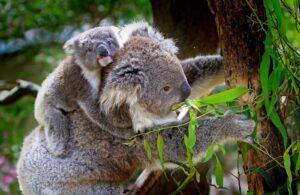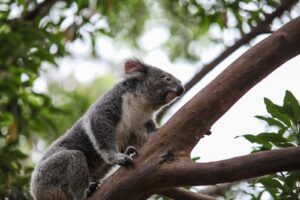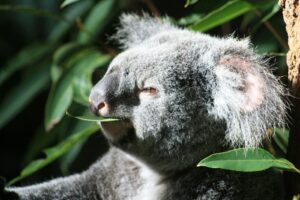The common misconception is that koalas are dumb because the koala brain is tiny. While the koala’s brain anatomy might be associated with some limitations in cognitive abilities, brain size to body weight ratio is not a meaningful way to compare intelligence.
The traditional assumption in mammals is that the brain and body size relationship is linear when viewed on a logarithmic scale. In reality, this relationship is curvilinear, meaning that as mammals increase body mass, their brain mass increases more slowly.
This finding has significant implications for understanding brain evolution and cognitive capacities. Different mammalian orders have different rates of brain size evolution, with primates, rodents, and carnivores exhibiting a stronger trend towards increasing relative brain size over time. This trend is particularly pronounced in primates, which suggests that natural selection has decoupled brain and body mass evolution in this group, potentially facilitating the development of higher cognitive abilities in species like humans.
Marsupials tend to have smaller brains than other mammals, and scientists do not use the brain-to-body ratio as an intelligence parameter.
In Koalas, the brain-to-body ratio is 75%, which differs from the often-quoted ratio of 61%. Yes, it is one of the smallest brains within mammals, but Koalas are not lazy and slow because of that but most likely because of their nutrition-poor diet of otherwise toxic eucalyptus leaves.
Koalas are endearing marsupials native to Australia, known for their cute appearance. As one of the most iconic Australian animals, understanding the koala brain is interesting and helpful if we want to help their conservation.
Main takeaways:
- Koalas Are Often Misunderstood: Despite having small brains, koalas are not “dumb.” Their brain size does not directly correlate with intelligence.
- Brain Anatomy Reflects Adaptation: Koalas have smooth brains with large olfactory bulbs adapted to their diet and environmental needs.
- Cognitive Abilities: Koalas demonstrate problem-solving skills, memory, social intelligence, and spatial awareness, particularly navigating their habitats.
- Environmental and Behavioral Adaptations: Koalas exhibit cognitive responses to extreme weather, adjusting their behaviour to cope with rising temperatures.
- Conservation Efforts Are Crucial: Koala populations are vulnerable due to habitat loss, climate change, and other factors, making conservation efforts vital for survival.
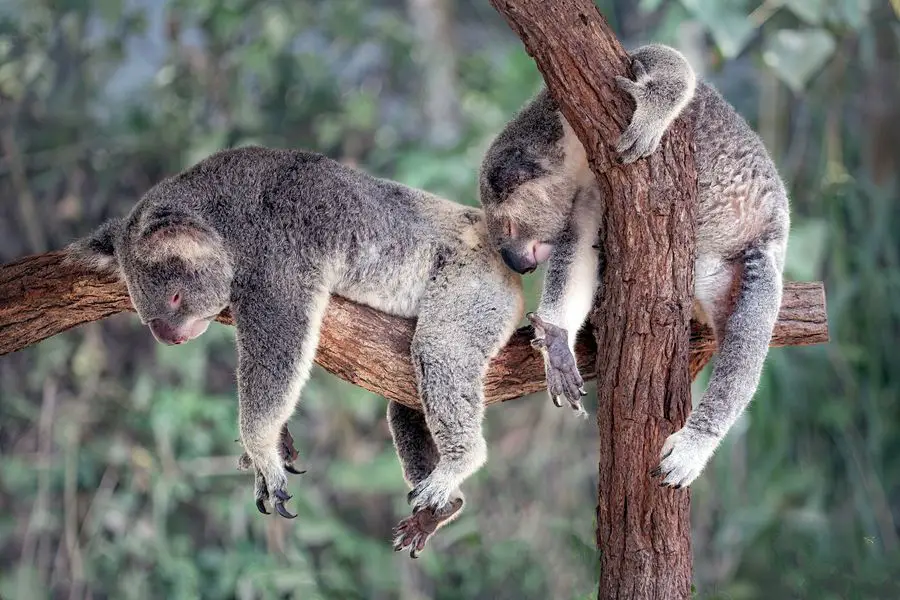
Basic Anatomy and Structure of the Koala Brain
The koala brain is relatively small, weighing approximately 19 grams, and significantly smaller than the brains of other mammals of similar body size. Interestingly, the koala brain has an unusually smooth surface, lacking the folds and grooves found in most mammalian brains. Due to poor diet and lower behaviour complexity, this smooth structure is probably related to their energy-conserving capacity (the brain burns less energy).
Here are some key features of koala brain anatomy:
- Size and proportion: On average, the koala’s brain weighs only 19.2 grams (0.68 ounces). It occupies roughly 75% of the cranial cavity, with cerebrospinal fluid filling the remaining space.
- Smoothness: Compared to many other mammals, the surface of a koala’s brain is relatively smooth. This smoothness, or lack of cortical folding (gyrification), is sometimes considered a characteristic of “primitive” animals. However, the extent of cortical folding also depends on body size; proper analysis is needed to determine its significance.
- Brain structure: Like other mammals, the koala brain is divided into several parts: the cerebrum, cerebellum, and brainstem. The cerebrum, responsible for higher cognitive functions, is smaller in koalas than other mammals. The cerebellum, which controls motor functions and coordination, is also relatively small.
- Olfactory bulbs: One notable feature of the koala brain is the presence of large olfactory bulbs. These structures are responsible for the sense of smell, which is well-developed in koalas. The keen sense of smell helps them detect and select the most suitable eucalyptus leaves for consumption.
How the Koala Brain Influences Behavior
- Feeding habits: Koalas have specialized brain regions that help them process the toxic compounds in eucalyptus leaves, allowing them to feed on this otherwise poisonous diet.
- Sleep patterns: Koalas sleep up to 20 hours a day to conserve energy, and their brain structure supports this energy-efficient lifestyle.
- Social behaviour and communication: The koala brain enables them to use vocalizations and body language to interact with other koalas.
- Mating rituals: The koala brain controls mating behaviour, including vocalizations and scent marking to attract potential mates.
Environmental Factors Impacting the Koala Brain
The koala brain is not immune to the effects of habitat loss, fragmentation, and climate change. These environmental stressors can profoundly impact koala brain development and cognitive function, potentially affecting their ability to find food, navigate, and reproduce.
Human interaction can also influence koala behaviours, with urbanization and increased human activity potentially causing stress and cognitive impairments in these animals.
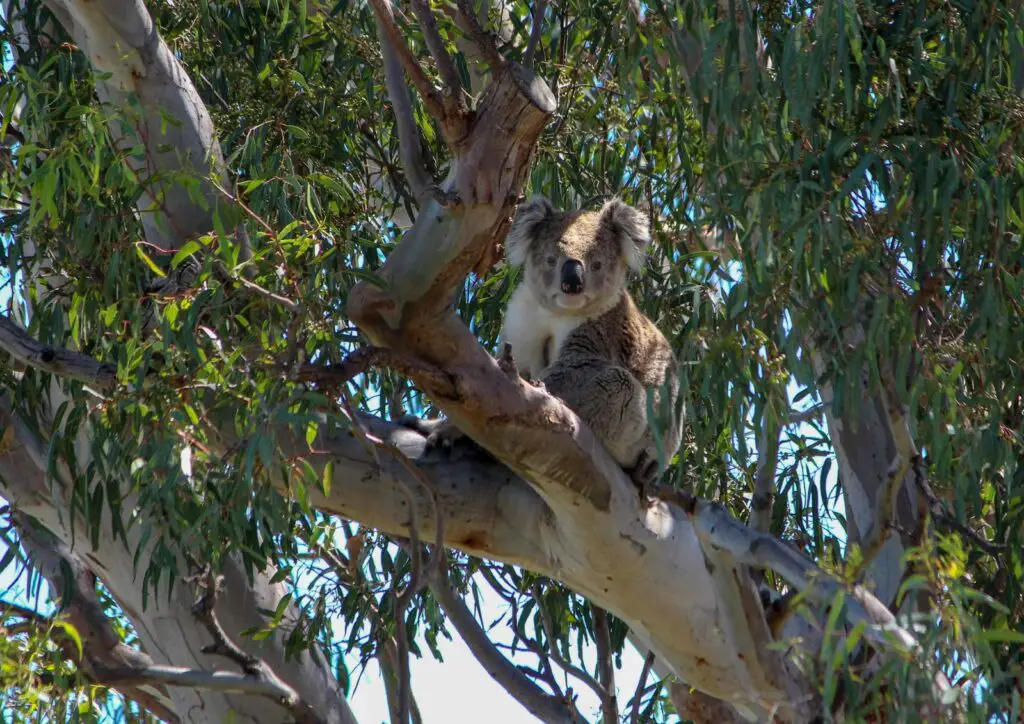
The Science Behind Animal Intelligence
Cognitive skills in mammals are typically assessed through various behavioural experiments and observational studies designed to evaluate various aspects of intelligence, such as problem-solving, memory, learning ability, and social cognition. These assessments often involve tasks that require the animal to navigate mazes, use tools, remember locations, or solve puzzles to obtain food rewards.
Researchers may also observe social interactions within groups to understand communication, cooperation, and the ability to understand others’ intentions.
In some cases, more advanced methods like brain imaging or neurological tests are used to study the underlying neural mechanisms of cognition. These assessments help scientists understand the complexity of cognitive abilities across different mammalian species and how these abilities have evolved.
- Problem-solving and reasoning: The ability to solve complex problems or use tools indicates a certain level of cognitive function.
- Social behaviours: Social animals often exhibit advanced cognitive skills, such as cooperation, deception, and empathy.
- Learning and adaptation: The capacity to learn from experiences, adapt to new environments, and modify behaviours is a sign of intelligence.
- Memory: A good memory helps animals remember locations, individuals, and past experiences, allowing them to make better decisions.
- Communication: Animals with complex communication systems often have advanced cognitive abilities, as they can convey information, express emotions, and even learn new signals.
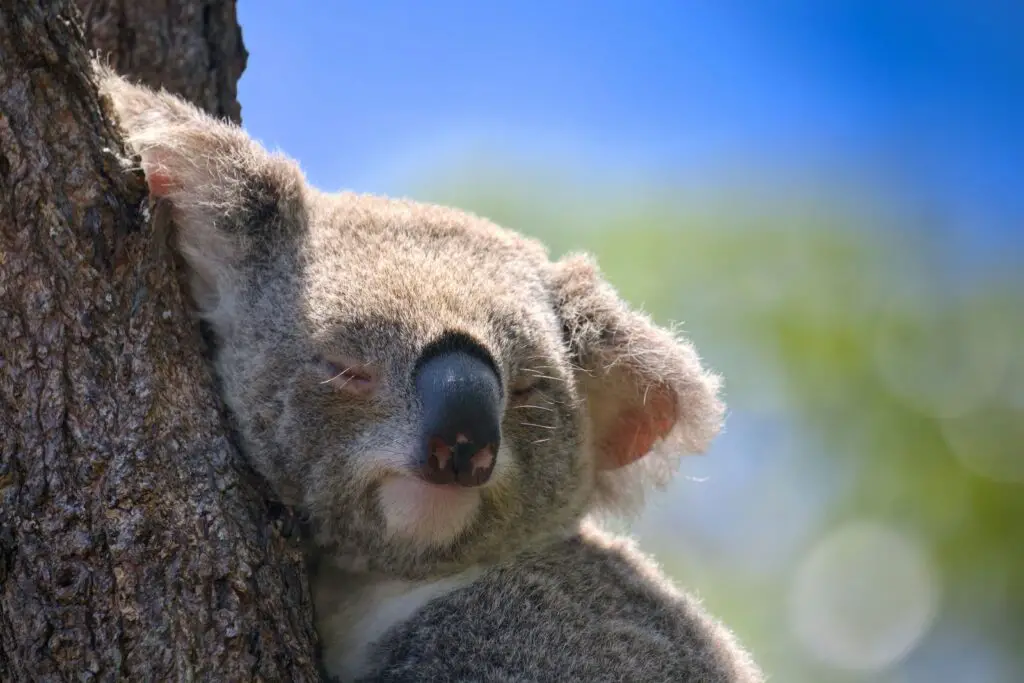
How Intelligent Are Koalas?
As for koalas, they have some traits that could be perceived as signs of lower intelligence and some that may indicate cognitive abilities:
Perceived signs of lower intelligence:
- Brain anatomy and brain size: Koalas have a smaller brain size and an anatomical brain structure, which could suggest limited cognitive capabilities.
- Limited diet: Koalas mainly eat eucalyptus leaves, which are toxic and low in nutrition.
- Inactivity: Koalas sleep for up to 18-22 hours a day to conserve energy, which might give the impression that they are lazy or inactive.
Indications of intelligence:
- Adaptation to a specialized diet: Koalas have evolved to digest eucalyptus leaves, a unique ability among mammals. This could be an adaptation to their environment rather than a limitation.
- Navigating complex environments: Koalas are arboreal animals and must navigate the complex environment of tree canopies to find food and avoid predators. This requires some level of spatial awareness and problem-solving skills.
- Social behaviours: While koalas are solitary animals, they communicate with each other using vocalizations and scent markings, which shows a degree of social interaction and communication skills.
It’s important to remember that intelligence is a complex and multi-dimensional concept, and it takes work to quantify or compare across species. Different animals have evolved to suit their specific environments and lifestyles, so their intelligence is often specialized and adapted to their unique needs.
Cognitive Abilities of Koalas
While koalas are not considered particularly intelligent compared to other mammals, they possess several cognitive abilities that allow them to thrive in their unique ecological niche. These include:
- Problem-solving skills: Koalas are adept at finding and selecting the best eucalyptus leaves, their primary food source, by utilizing their senses of smell and taste.
- Memory capabilities: Koalas can remember the locations of their favourite eucalyptus trees and navigate back to them when needed.
- Social intelligence: Koalas communicate using a range of vocalizations and body language to establish social hierarchies and maintain relationships.
- Navigation and spatial awareness: Koalas have an excellent sense of spatial awareness, which aids them in navigating their treetop environment.
One of the most interesting recent findings is that Koalas exhibit cognitive responses to weather conditions, particularly extreme heat. Research indicates that koalas can anticipate and respond to environmental temperature changes, adjusting their behaviour and physiological processes accordingly. For instance, koalas can preemptively lower their body temperature in the morning on extremely hot days, providing a buffer to store heat throughout the day, thus minimizing the need for evaporative cooling during the hottest periods. This behaviour suggests that koalas can predict upcoming extreme temperatures and adjust their thermoregulation strategies to cope with these conditions.
Koalas utilize a combination of cognitive predictions and behavioural strategies to mitigate the impacts of extreme weather, which is increasingly important given the rising frequency and intensity of heat waves due to climate change.
Conservation efforts
Koalas are not considered endangered globally but are classified as “Vulnerable” by the International Union for Conservation of Nature (IUCN) Red List. However, their populations have declined due to several factors, including habitat loss, climate change, disease, and bushfires.
In some regions of Australia, koalas face more severe threats, and their status may be more precarious. In 2012, koalas in New South Wales, Queensland, and the Australian Capital Territory were listed as “Vulnerable” under Australia’s Environment Protection and Biodiversity Conservation Act 1999. Conservation efforts are ongoing to protect and restore koala habitats and help their populations recover.
Conclusions
The common misconception that koalas are dumb due to their tiny brains is not a fair assessment of their cognitive abilities. While the koala’s brain anatomy might have some limitations, the brain size to body weight ratio is not a reliable measure of intelligence. The traditional view that brain and body size are linearly related on a logarithmic scale is inaccurate; the relationship is curvilinear. This curvilinear relationship suggests that as mammals increase body mass, their brain mass increases slower, which has significant implications for understanding brain evolution and cognitive abilities.
Koalas, like other marsupials, have smaller brains than mammals. Their brain-to-body ratio is about 75%, slightly higher than the often-cited figure of 61%. Despite having one of the smallest brains among mammals, koalas are not lazy or slow due to their brain size but likely because of their nutrient-poor diet of toxic eucalyptus leaves.
The koala brain, weighing approximately 19 grams, is small and relatively smooth, which might relate to their energy-conserving lifestyle. Despite this, koalas have several cognitive abilities that allow them to thrive in their ecological niche. These include problem-solving skills in selecting eucalyptus leaves, memory capabilities for navigating and remembering tree locations, social intelligence through communication, and spatial awareness for navigating treetops. Additionally, koalas exhibit cognitive responses to extreme weather conditions, adjusting their behaviour and physiological processes to cope with temperature changes.
In conclusion, while koalas may not rank highly on traditional measures of mammalian intelligence, their cognitive abilities are well-suited to their unique environmental needs. Understanding these abilities is crucial for effective conservation efforts, especially as koalas face increasing threats from habitat loss, climate change, and other environmental stressors.

